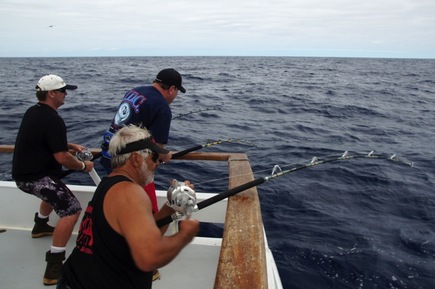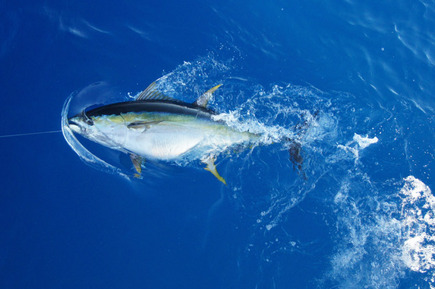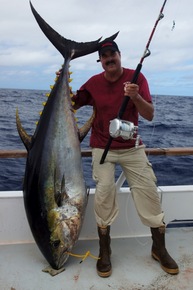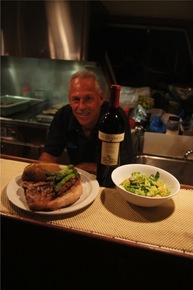Long Range Fish Report
From Sportfishing
From Sportfishing
Fish Report for 11-21-2011
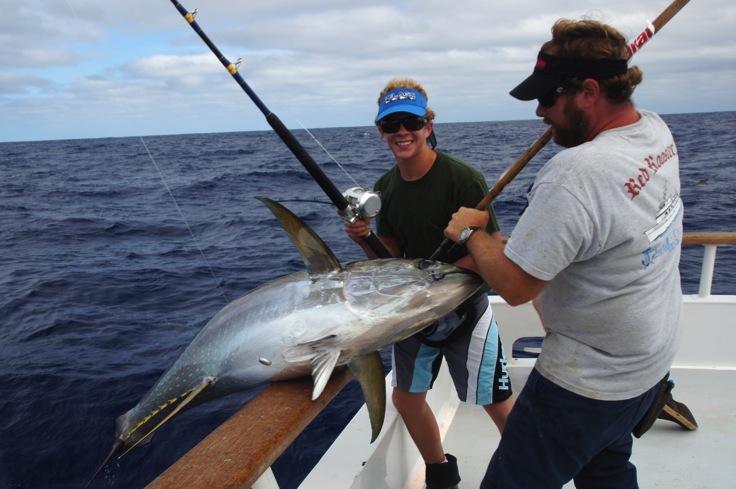
Red Rooster III has a ig Tuna Cake with Wahoo Frosting on its Accurate Reels Trip
11-21-2011
Bill Roecker
https://www.redrooster3.com/
Paul Sweeney and I returned from a wonderful ten-day flyback trip late Sunday night, November 20. The Accurate trip with chartermaster Jack Nilsen filled the boat with big tuna, a sweet cake frosted with a good morning of wahoo fishing, in weather that was just as tasty. The storm approaching San Diego as we left passed over us on the way down with no more discomfort than a day of rain, and turned to clear skies and subsiding seas that flattened more with each of the five days we spent fishing off the newly greened island of Clarion. As though to remind us of our luck, we flew into LAX in a rainstorm, and down to San Diego in the tail end of another dousing of the Southwest's most precious resource.
Many of the 23 anglers aboard got the best tuna of their fishing careers, and that included Paul and I. He picked off an estimated 170-pounder on the kite using the Accurate ATD 80 reel they call "The Tractor," and I saw my first cow hit the deck. It wouldn't have arrived there had I not had the assistance of second skipper Derek Waldman, who bailed me out of a couple of near-spoolings. That was the fish from Heck at the least, and it made seven long runs on my 100-pound gear, three of which allowed me to view the end of the more than 500 yards of new Kanzen spectra on my Accurate 12. Tom Ferrari also was my much-appreciated big fish saver the next day. On our way south, many wonderful prizes were given to all anglers, and a drawing was held for some expensive items (rods from Calstar and Seeker, 500-yard spools of Kanzen and packets of 30, 40 and 50-pound Seaguar, Red Rooster III prints from Peter J, an AFTCO harness and Socorro belt, copies of At The Rail, etc.) More goodies like Mustad hooks, Salas iron jigs and Zuckers trolling jigs and calendars went into another packet for everyone.
There were plenty of big fish for all on the trip; yellowfin of up to the taped 274-pounder caught by "Big Al" Waldbridge of Ojai, once a high school basketball star there and now a successful farmer of avocados and other produce. It was his first cow. The weights mentioned here will become official after the Rooster arrives November 23 with most of the long range fleet, just in time for Thanksgiving.
The next apparent best tuna was taped at 244, for rookie Denny Hill of Santa Clarita, under the wing of the trip's best angler, Brandon Hayward, the saltwater editor at WON. Brandon's ability to hook and handle big tuna on a seven-foot Calstar with 100-pound spectra and a couple feet of flourocarbon inspired me to try a similar rig, and right away I found it effective.
I'd given up on the concept about ten years ago, because the heavy shaking of big tuna on the initial runs "like to tore my arms out of their sockets." But the new longer "rail rods" with lighter tips seems to make a big difference, and the spectra-to-flourocarbon combo gets bit like your best hopes. I'm sold, thanks to Brandon. My own rig made use of a new Super Seeker 1 X 3 rod wrapped for me by Pat Doyle, an Accurate 12 with Seaguar Premier 100-pound at the end of the 100-pound Kanzen I was trying out, and a super-strong Mustad Demon 4X circle hook in 6/0 size, hooked in a sardine. I tried the 'dine nose, back and belly-hooked and got bit all ways, though I still favor the nose-hook as the usual method for soaking at a distance. I got one fish and saw a couple of other hooked "on the grind" that way.
Captain Andy Cates put us on the fish every day, and recommended fishing 100-pound line and leader on the sardines and 130-pound gear for bigger baits like mackerel. They bit each dawn, at mid-morn and again in the afternoon and at sunset. It made for drift fishing in great style, with drifts lasting from 20 minutes to a couple of hours, before we'd run upwind again to start over. The worst thing about fishing sardines was contending with the juvenile boobies that pounced on baits they could see or reach.
Most anglers compensated for the birds by putting a two-ounce egg sinker two or three feet up from the hook. Dropping the bait in close to the boat was another option to avoid bird strikes. Sharks were not much of a hassle, I'm pleased to report. We lost only a few fish to them, and they didn't seem interested in the small baits.
Cleaning some for meals and purging a couple of big fish demonstrated they were eating lots of pelagic red crab, along with small rockfish and a few elongated baits, along with our sardines. The water was a fine 78 to 79 degrees, clear blue-purple and just right for yellowfin. We spent our last morning fishing for wahoo to squeeze in among the tuna plugging a hold of refrigerated sea water, after we finished off two brine holds of fish caught earlier. I started out with a hot hand, getting the first jig fish on a silver Sea Strike 33 and then another right away. I wasn't so lucky on the next one, which spit the jig. But I was more than pleased to get that brace for the fresh hold, and didn't lose the jig, which Waldman had attached for me with 40-pound Izorline XXX with a double line Bimini knot. Three strikes, two wahoo on the deck and no jig loss; that's about as good as it gets for me.
I took a look at Hayward, fishing a 9-foot Ulua, who'd haywired a short piece of wire to his spectra, and tricked several skins to attack his Salas 7X "Python" or a "Gay Soldier" with a "normal" slow retrieve on the slide. I saw one appear from the side and grab the jig in the center. A look at the jig after the fish was decked confirmed my observation, which Brandon had missed because he turned his head at the moment of the attack. He got that one and several others with the same method, and I'll now refer to him affectionately as "Haywire." His method will be something else for me to try on my next trip into the waters where the skinnies live.
Others got skinnies on bait, Raiders and other long, heavy jigs. We had numerous stops, some initiated by short strikes, which produced nothing on the trolled jigs, but proved wahoo were waiting for dropback offerings. The Marauders did their usual good job of producing skinnies for the trollers.
Fishing in the Buffer Zone off Clarion Island on a ten-day excursion with the flyback option is a smart option. We were there because the tuna on the southern banks weren't biting well when we left port. As skipper Cates said, "Drift fishing was classic. We had fish of 80 to 140 pounds every morning, and 120 to 180 pounds in the afternoon. I don't see why more people don't do this. Five days of catching big tuna puts a lot of fish on the boat, with just about all the fishing you can take, and you don't have to make that long ride home."
It wouldn't be proper for me to end this story with a grateful thanks to this trip's sponsors: Accurate, AFTCO, Calstar, Five Star, Izorline, Mustad, Salas, Seaguar, Seeker, Sportsman's Seafood, Zuckers and others. Jack Nilsen gets kudos for putting the trip on and embellishing it with over $50,000 worth of loaner reels and rods. Jack was assisted by Leo Reihsen and Gary Gillingham, who helped any and all anglers who needed it.
I'd also like to applaud Cates and his fine crew of Derek Waldman, Tom Ferrari, Fernando Calleros, Julio Ochoa and chefs Rick Shedd and Chapman Murphey. The food was excellent, right on, and with their help I was for once proud to return without gaining unwanted weight.
We gave the Sportsman's award of my book At The Rail, a copy of the IGFA yearbook, a new Salas 7X and a Five Star discount certificate to Bob Peterson of San Diego, who brought his 18-year-old son Caleb, in the main photo, on his first long range trip. Caleb wanted a 100-pounder. The tuna obliged him beyond his hopes, repeatedly, and made him a new long ranger, a young man who'll be back, again and again, without doubt. Bob was also rewarded with first cow, taped at 222 pounds.
So what do I really think about this trip on the Red Rooster III? Delicious.
Many of the 23 anglers aboard got the best tuna of their fishing careers, and that included Paul and I. He picked off an estimated 170-pounder on the kite using the Accurate ATD 80 reel they call "The Tractor," and I saw my first cow hit the deck. It wouldn't have arrived there had I not had the assistance of second skipper Derek Waldman, who bailed me out of a couple of near-spoolings. That was the fish from Heck at the least, and it made seven long runs on my 100-pound gear, three of which allowed me to view the end of the more than 500 yards of new Kanzen spectra on my Accurate 12. Tom Ferrari also was my much-appreciated big fish saver the next day. On our way south, many wonderful prizes were given to all anglers, and a drawing was held for some expensive items (rods from Calstar and Seeker, 500-yard spools of Kanzen and packets of 30, 40 and 50-pound Seaguar, Red Rooster III prints from Peter J, an AFTCO harness and Socorro belt, copies of At The Rail, etc.) More goodies like Mustad hooks, Salas iron jigs and Zuckers trolling jigs and calendars went into another packet for everyone.
There were plenty of big fish for all on the trip; yellowfin of up to the taped 274-pounder caught by "Big Al" Waldbridge of Ojai, once a high school basketball star there and now a successful farmer of avocados and other produce. It was his first cow. The weights mentioned here will become official after the Rooster arrives November 23 with most of the long range fleet, just in time for Thanksgiving.
The next apparent best tuna was taped at 244, for rookie Denny Hill of Santa Clarita, under the wing of the trip's best angler, Brandon Hayward, the saltwater editor at WON. Brandon's ability to hook and handle big tuna on a seven-foot Calstar with 100-pound spectra and a couple feet of flourocarbon inspired me to try a similar rig, and right away I found it effective.
I'd given up on the concept about ten years ago, because the heavy shaking of big tuna on the initial runs "like to tore my arms out of their sockets." But the new longer "rail rods" with lighter tips seems to make a big difference, and the spectra-to-flourocarbon combo gets bit like your best hopes. I'm sold, thanks to Brandon. My own rig made use of a new Super Seeker 1 X 3 rod wrapped for me by Pat Doyle, an Accurate 12 with Seaguar Premier 100-pound at the end of the 100-pound Kanzen I was trying out, and a super-strong Mustad Demon 4X circle hook in 6/0 size, hooked in a sardine. I tried the 'dine nose, back and belly-hooked and got bit all ways, though I still favor the nose-hook as the usual method for soaking at a distance. I got one fish and saw a couple of other hooked "on the grind" that way.
Captain Andy Cates put us on the fish every day, and recommended fishing 100-pound line and leader on the sardines and 130-pound gear for bigger baits like mackerel. They bit each dawn, at mid-morn and again in the afternoon and at sunset. It made for drift fishing in great style, with drifts lasting from 20 minutes to a couple of hours, before we'd run upwind again to start over. The worst thing about fishing sardines was contending with the juvenile boobies that pounced on baits they could see or reach.
Most anglers compensated for the birds by putting a two-ounce egg sinker two or three feet up from the hook. Dropping the bait in close to the boat was another option to avoid bird strikes. Sharks were not much of a hassle, I'm pleased to report. We lost only a few fish to them, and they didn't seem interested in the small baits.
Cleaning some for meals and purging a couple of big fish demonstrated they were eating lots of pelagic red crab, along with small rockfish and a few elongated baits, along with our sardines. The water was a fine 78 to 79 degrees, clear blue-purple and just right for yellowfin. We spent our last morning fishing for wahoo to squeeze in among the tuna plugging a hold of refrigerated sea water, after we finished off two brine holds of fish caught earlier. I started out with a hot hand, getting the first jig fish on a silver Sea Strike 33 and then another right away. I wasn't so lucky on the next one, which spit the jig. But I was more than pleased to get that brace for the fresh hold, and didn't lose the jig, which Waldman had attached for me with 40-pound Izorline XXX with a double line Bimini knot. Three strikes, two wahoo on the deck and no jig loss; that's about as good as it gets for me.
I took a look at Hayward, fishing a 9-foot Ulua, who'd haywired a short piece of wire to his spectra, and tricked several skins to attack his Salas 7X "Python" or a "Gay Soldier" with a "normal" slow retrieve on the slide. I saw one appear from the side and grab the jig in the center. A look at the jig after the fish was decked confirmed my observation, which Brandon had missed because he turned his head at the moment of the attack. He got that one and several others with the same method, and I'll now refer to him affectionately as "Haywire." His method will be something else for me to try on my next trip into the waters where the skinnies live.
Others got skinnies on bait, Raiders and other long, heavy jigs. We had numerous stops, some initiated by short strikes, which produced nothing on the trolled jigs, but proved wahoo were waiting for dropback offerings. The Marauders did their usual good job of producing skinnies for the trollers.
Fishing in the Buffer Zone off Clarion Island on a ten-day excursion with the flyback option is a smart option. We were there because the tuna on the southern banks weren't biting well when we left port. As skipper Cates said, "Drift fishing was classic. We had fish of 80 to 140 pounds every morning, and 120 to 180 pounds in the afternoon. I don't see why more people don't do this. Five days of catching big tuna puts a lot of fish on the boat, with just about all the fishing you can take, and you don't have to make that long ride home."
It wouldn't be proper for me to end this story with a grateful thanks to this trip's sponsors: Accurate, AFTCO, Calstar, Five Star, Izorline, Mustad, Salas, Seaguar, Seeker, Sportsman's Seafood, Zuckers and others. Jack Nilsen gets kudos for putting the trip on and embellishing it with over $50,000 worth of loaner reels and rods. Jack was assisted by Leo Reihsen and Gary Gillingham, who helped any and all anglers who needed it.
I'd also like to applaud Cates and his fine crew of Derek Waldman, Tom Ferrari, Fernando Calleros, Julio Ochoa and chefs Rick Shedd and Chapman Murphey. The food was excellent, right on, and with their help I was for once proud to return without gaining unwanted weight.
We gave the Sportsman's award of my book At The Rail, a copy of the IGFA yearbook, a new Salas 7X and a Five Star discount certificate to Bob Peterson of San Diego, who brought his 18-year-old son Caleb, in the main photo, on his first long range trip. Caleb wanted a 100-pounder. The tuna obliged him beyond his hopes, repeatedly, and made him a new long ranger, a young man who'll be back, again and again, without doubt. Bob was also rewarded with first cow, taped at 222 pounds.
So what do I really think about this trip on the Red Rooster III? Delicious.
Photos
< Previous Report Next Report >
More Reports
Fishing Videos Reports
for Monday, November 21st, 2011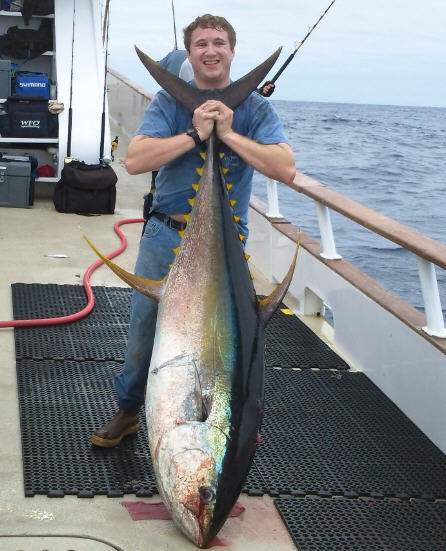
• American Angler finishes with a Bang
• Independence has "Classic Big Fishing"
• Intrepid hits the Jackpot with Skins
• Qualifier 105 vists "Yellowtail Island"
• Royal Polaris has an amazing Yellowfin Tuna Trip with 12 to 15 fish over 200 lbs.
Fishing Videos Reports
for Monday, November 7th, 2011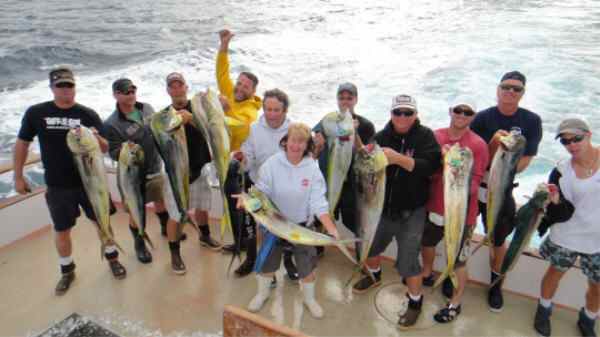
• Working Uphill
• Royal Polaris reports that the wind did not keep big Yellowfin from biting
• American Angler on a Yellowtial Mission, November 7, 2011
• The Independence Reports "Excellent" Yellowfin Fishing, November 7, 2011
• The Intrepid starts the day looking for some new areas on their Larry Brown Trip
• The Qualifier 105 finds the "Big Fish Zone"
• Royal Polaris Has a Dorado Strike

LongRangeSportfishing.net © 2025. All Rights Reserved.
Website Hosting and Design provided by TECK.net
Website Hosting and Design provided by TECK.net
